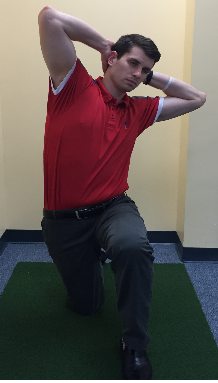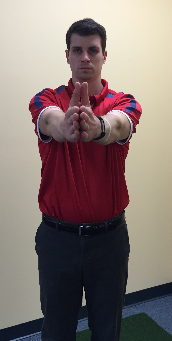05/06/2019
Rehabilitation Services: Two Tips to Improve Your Golf Game
By: Ryan Hubbard, Titleist Certified Level One Physical Therapist, Wentworth-Douglass Hospital Physical Therapy at The Works
As a Titleist Certified Level One Physical Therapist I work with golfers on performance, fitness, and injury prevention. Here are some tips I hope can help you improve your golf game in 2019 and beyond.
I use the Titleist physical screening tool to evaluate my golfing patients’ swings. What I often find is that they have poor mobility of their thoracic spine. The thoracic spine is your upper back and where we achieve most of our back rotation. All rotary sports, such as baseball and golf, require this part of your back to be able to contribute a certain amount of rotation. If this area is stiff, then other parts of your body must compensate to complete your swing. One of these areas being your low back. Your low back is not meant to be a point of excess rotation due to the orientation of its bony anatomy and added compression of your discs. One study found that compression at the low back during the golf swing is about 8 times your body weight (in comparison, running is about 3 times your bodyweight). If this is already occurring, why add more strain on the low back than you have to? There are many reasons why someone may have low back pain during the golf swing, but in many cases I have seen mid back and hip mobility, or lack thereof, tend to be contributing factors.
One of the primary causes for the lack of mobility in the thoracic spine is due to our posture. Most of us have forward flexed posture because we are sitting 90% of our day. We sleep in a flexed posture, drive to work, sit at our desks, drive home, eat dinner at the table, and then start the cycle all over again. This causes our upper back to be in a position of flexion and stay in this position of stiffness. Once in this position, it is difficult for us to move into an upright position and rotate. Think about it, how many times have you driven to the golf course within 15 minutes of your tee time, maybe hit a few putts, took a few half-hearted practice swings, and miss-hit your first tee shot? You’re already setting yourself at a disadvantage, even before you set your ball on the tee.
What’s great is that you can get your upper back moving more freely in two minutes time. Below you will find a couple of my favorite golf warm up exercises for the upper back. Try them out before your next round, on your lunch break, or before bed to counteract the sitting you do throughout the day. I promise you’ll see a difference in the way you feel when you swing.
 1. Thoracic turns with side bending in half kneeling (5X each side)
1. Thoracic turns with side bending in half kneeling (5X each side)
Bend down on your right knee to assume the half kneeling position with your left foot forward. Interlock your hands behind your head and rotate your upper trunk to the left side as far as you can. Side bend towards the left with your upper trunk while maintaining the left rotation maximally. See if you can rotate more to the left. Repeat to the left five more times, then switch legs and repeat to the other side.
 2. Standing reverse flys x 30
2. Standing reverse flys x 30
Start with your arms out front and palms together. Keeping arms parallel with floor, open arms out to side to pinch your shoulder blades together, and then return to the starting position. If you would like added activation of your shoulder blade muscles, you can progress this exercise with a light resistance band.
Wentworth-Douglass Hospital Rehabilitation Services offers physical therapy at four convenient locations in Dover, Lee, Durham and at The Works Family Health & Fitness Center in Somersworth. Learn more about Rehabilitation Services or call (603) 740-2101.